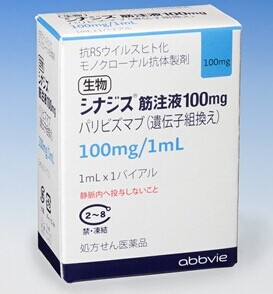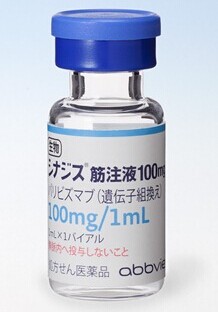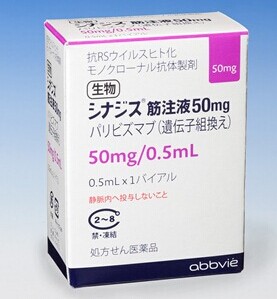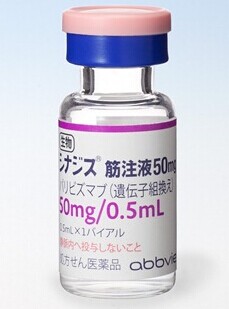|
英文药名:Synagis injection(Palivizumab[Genetical Recombination]) 中文药名:重组帕利珠单抗注射剂 生产厂家:雅培制药 DESCRIPTION: Synagis (palivizumab) is a humanized monoclonal antibody (IgG1κ ) produced by recombinant DNA technology, directed to an epitope in the A antigenic site of the F protein of respiratory syncytial virus (RSV). Synagis is a composite of human (95%) and murine (5%) antibody sequences. The human heavy chain sequence was derived from the constant domains of human IgG1 and the variable framework regions of the VH genes Cor (1) and Cess (2). The human light chain sequence was derived from the constant domain of Cκ and the variable framework regions of the VL gene K104 with Jκ -4 (3). The murine sequences were derived from a murine monoclonal antibody, Mab 1129 (4), in a process that involved the grafting of the murine complementarity determining regions into the human antibody frameworks. Synagis is composed of two heavy chains and two light chains and has a molecular weight of approximately 148,000 Daltons. Synagis is supplied as a sterile, preservative-free liquid solution at 100 mg/mL to be administered by intramuscular injection (IM). Thimerosal or other mercury containing salts are not used in the production of Synagis. The solution has a pH of 6.0 and should appear clear or slightly opalescent. Each 100 mg single-dose vial of Synagis liquid solution contains 100 mg of Synagis, 3.9 mg of histidine, 0.1 mg of glycine, and 0.5 mg of chloride in a volume of 1 mL. Each 50 mg single-dose vial of Synagis liquid solution contains 50 mg of Synagis, 1.9 mg of histidine, 0.06 mg of glycine, and 0.2 mg of chloride in a volume of 0.5 mL. Mechanism of Action: Synagis exhibits neutralizing and fusion-inhibitory activity against RSV. These activities inhibit RSV replication in laboratory experiments. Although resistant RSV strains may be isolated in laboratory studies, a panel of 57 clinical RSV isolates were all neutralized by Synagis (5). Synagis serum concentrations of ≥ 40 mcg/mL have been shown to reduce pulmonary RSV replication in the cotton rat model of RSV infection by 100-fold (5). The in vivo neutralizing activity of the active ingredient in Synagis was assessed in a randomized, placebo-controlled study of 35 pediatric patients tracheally intubated because of RSV disease. In these patients, Synagis significantly reduced the quantity of RSV in the lower respiratory tract compared to control patients (6). Pharmacokinetics: In pediatric patients < 24 months of age without congenital heart disease (CHD), the mean half-life of Synagis was 20 days and monthly intramuscular doses of 15 mg/kg achieved mean ±SD 30 day trough serum drug concentrations of 37± 21 mcg/mL after the first injection, 57 ± 41 mcg/mL after the second injection, 68 ± 51 mcg/mL after the third injection and 72 ± 50 mcg/mL after the fourth injection (7). Trough concentrations following the first and fourth Synagis dose were similar in children with CHD and in non-cardiac patients. In pediatric patients given Synagis for a second season, the mean ±SD serum concentrations following the first and fourth injections were 61 ± 17 mcg/mL and 86 ± 31mcg/mL, respectively. In 139 pediatric patients ≤ 24 months of age with hemodynamically significant CHD who received Synagis and underwent cardio-pulmonary bypass for open-heart surgery, the mean ± SD serum Synagis concentration was 98+ 52 mcg/mL before bypass and declined to 41+ 33 mcg/mL after bypass, a reduction of 58% (see DOSAGE AND ADMINISTRATION). The clinical significance of this reduction is unknown. Specific studies were not conducted to evaluate the effects of demographic parameters on Synagis systemic exposure. However, no effects of gender, age, body weight or race on Synagis serum trough concentrations were observed in a clinical study with 639 pediatric patients with CHD (≤24 months of age) receiving five monthly intramuscular injections of 15 mg/kg of Synagis. The pharmacokinetics and safety of Synagis liquid solution and Synagis lyophilized formulation administered IM at 15 mg/kg were studied in a cross-over trial of 153 pediatric patients ≤6 months of age with a history of prematurity. The results of this trial indicated that the trough serum concentrations of palivizumab were comparable between the liquid solution and the lyophilized formulation, which was the formulation used in the clinical studies described below. CLINICAL STUDIES: The safety and efficacy of Synagis were assessed in two randomized, double-blind, placebo-controlled trials of prophylaxis against RSV infection in pediatric patients at high risk of an RSV-related hospitalization. Trial 1 was conducted during a single RSV season and studied a total of 1,502 patients ≤ 24 months of age with bronchopulmonary dysplasia (BPD) or infants with premature birth (≤ 35 weeks gestation) who were ≤ 6 months of age at study entry (7). Trial 2 was conducted over four consecutive seasons among a total of 1287 patients ≤ 24 months of age with hemodynamically significant congenital heart disease. In both trials participants received 15 mg/kg Synagis or an equivalent volume of placebo IM monthly for five injections and were followed for 150 days from randomization. In Trial 1, 99% of all subjects completed the study and 93% completed all five injections. In Trial 2, 96% of all subjects completed the study and 92% completed all five injections. The incidence of RSV hospitalization is shown in Table 1.
In Trial 1, the reduction of RSV hospitalization was observed both in patients with BPD (34/266 [12.8%] placebo vs. 39/496 [7.9%] Synagis), and in premature infants without BPD (19/234 [8.1%] placebo vs. 9/506 [1.8%] Synagis). In Trial 2, reductions were observed in acyanotic (36/305 [11.8%] placebo versus 15/300 [5.0%] Synagis) and cyanotic children (27/343 [7.9%] placebo versus 19/339 [5.6%] Synagis). The clinical studies do not suggest that RSV infection was less severe among RSV hospitalized patients who received Synagis compared to those who received placebo. INDICATIONS AND USAGE: Synagis is indicated for the prevention of serious lower respiratory tract disease caused by respiratory syncytial virus (RSV) in pediatric patients at high risk of RSV disease. Safety and efficacy were established in infants with bronchopulmonary dysplasia (BPD), infants with a history of premature birth (≤ 35 weeks gestational age), and children with hemodynamically significant congenital heart disease (CHD) (see CLINICAL STUDIES). CONTRAINDICATIONS: Synagis should not be used in pediatric patients with a history of a severe prior reaction to Synagis or other components of this product. WARNINGS: Very rare cases of anaphylaxis (<1 case per 100,000 patients) have been reported following re-exposure to Synagis (see ADVERSE REACTIONS, Post-Marketing Experience). Severe acute hypersensitivity reactions, estimated to be rare, (<1 case per 1,000 patients) have also been reported on initial exposure or re-exposure to Synagis (see ADVERSE REACTIONS, Post-Marketing Experience). If a severe hypersensitivity reaction occurs, therapy with Synagis should be permanently discontinued. If milder hypersensitivity reactions occur, caution should be used on readministration of Synagis. If anaphylaxis or severe allergic reactions occur, administer appropriate medications (e.g., epinephrine) and provide supportive care as required. PRECAUTIONS: General: Synagis is for intramuscular use only. As with any intramuscular injection, Synagis should be given with caution to patients with thrombocytopenia or any coagulation disorder. The safety and efficacy of Synagis have not been demonstrated for treatment of established RSV disease. The single-dose vial of Synagis does not contain a preservative. Administration of Synagis should occur immediately after dose withdrawal from the vial. The vial should not be re-entered. Discard any unused portion. Drug Interactions: No formal drug-drug interaction studies were conducted. In Trial 1, the proportions of patients in the placebo and Synagis groups who received routine childhood vaccines, influenza vaccine, bronchodilators or corticosteroids were similar and no incremental increase in adverse reactions was observed among patients receiving these agents. Carcinogenesis, Mutagenesis, Impairment of Fertility: Carcinogenesis, mutagenesis and reproductive toxicity studies have not been performed. Pregnancy: Pregnancy Category C: Synagis is not indicated for adult usage and animal reproduction studies have not been conducted. It is also not known whether Synagis can cause fetal harm when administered to a pregnant woman or could affect reproductive capacity. ADVERSE REACTIONS: The most serious adverse reactions occurring with Synagis treatment are anaphylaxis and other acute hypersensitivity reactions (see WARNINGS). The adverse reactions most commonly observed in Synagis-treated patients were upper respiratory tract infection, otitis media, fever, rhinitis, rash, diarrhea, cough, vomiting, gastroenteritis, and wheezing. Upper respiratory tract infection, otitis media, fever, and rhinitis occurred at a rate of 1% or greater in the Synagis group compared to placebo (Table 2). Because clinical trials are conducted under widely varying conditions, adverse event rates observed in the clinical trials of a drug cannot be directly compared to rates in the clinical trials of another drug and may not reflect the rates observed in practice. The adverse reaction information does, however, provide a basis for identifying the adverse events that appear to be related to drug use and a basis for approximating rates. The data described reflect Synagis exposure for 1641 pediatric patients of age 3 days to 24.1 months in Trials 1 and 2. Among these patients, 496 had bronchopulmonary dysplasia, 506 were premature birth infants less than 6 months of age, and 639 had congenital heart disease. Adverse events observed in the 153 patient crossover study comparing the liquid and lyophilized formulations were similar between the two formulations, and similar to the adverse events observed with Synagis in Trials 1 and 2.
In Trial 1, the incidence of anti-Synagis antibody following the fourth injection was 1.1% in the placebo group and 0.7% in the Synagis group. In pediatric patients receiving Synagis for a second season, one of the fifty-six patients had transient, low titer reactivity. This reactivity was not associated with adverse events or alteration in serum concentrations. Immunogenicity was not assessed in Trial 2. These data reflect the percentage of patients whose test results were considered positive for antibodies to Synagis in an ELISA assay, and are highly dependent on the sensitivity and specificity of the assay. Additionally, the observed incidence of antibody positivity in an assay may be influenced by several factors including sample handling, concomitant medications, and underlying disease. For these reasons, comparison of the incidence of antibodies to Synagis with the incidence of antibodies to other products may be misleading. With any monoclonal antibody, the possibility exists that a liquid solution may be more immunogenic than a lyophilized formulation. The relative immunogenicity rates between the lyophilized formulation, used in Trials 1 and 2 above, and the liquid solution have not yet been established. Post-Marketing Experience The following adverse reactions have been identified and reported during post-approval use of Synagis. Because the reports of these reactions are voluntary and the population is of uncertain size, it is not always possible to reliably estimate the frequency of the reaction or establish a causal relationship to drug exposure. Blood and Lymphatic System Disorders: severe thrombocytopenia (platelet count < 50,000/microliter) General Disorders and Administration Site Conditions: injection site reactions Immune System Disorders: severe acute hypersensitivity reactions and anaphylaxis (including dyspnea, cyanosis, respiratory failure, urticaria, pruritus, angioedema, hypotonia and unresponsiveness) have been reported (see WARNINGS). None of the reported hypersensitivity reactions were fatal. The relationship between these reactions and the development of antibodies to Synagis is unknown. Limited information from post-marketing reports suggests that, within a single RSV season, adverse events after a sixth or greater dose of Synagis are similar in character and frequency to those after the initial five doses. OVERDOSAGE: No data from clinical studies are available on overdosage. No toxicity was observed in rabbits administered a single intramuscular or subcutaneous injection of Synagis at a dose of 50 mg/kg. DOSAGE AND ADMINISTRATION: The recommended dose of Synagis is 15 mg/kg of body weight. Patients, including those who develop an RSV infection, should continue to receive monthly doses throughout the RSV season. The first dose should be administered prior to commencement of the RSV season. In the northern hemisphere, the RSV season typically commences in November and lasts through April, but it may begin earlier or persist later in certain communities. Synagis serum levels are decreased after cardio-pulmonary bypass (see CLINICAL PHARMACOLOGY). Patients undergoing cardio-pulmonary bypass should receive a dose of Synagis as soon as possible after the cardio-pulmonary bypass procedure (even if sooner than a month from the previous dose). Thereafter, doses should be administered monthly. Synagis should be administered in a dose of 15 mg/kg intramuscularly using aseptic technique, preferably in the anterolateral aspect of the thigh. The gluteal muscle should not be used routinely as an injection site because of the risk of damage to the sciatic nerve. The dose per month = patient weight (kg) x 15 mg/kg ÷ 100 mg/mL of Synagis. Injection volumes over 1 mL should be given as a divided dose. Administration of Synagis
HOW SUPPLIED: Synagis is supplied in single-dose vials as a preservative-free, sterile liquid solution at 100 mg/mL for IM injection. 50 mg vial NDC 60574-4114-1 The 50 mg vial contains 50 mg Synagis in 0.5 mL. 100 mg vial NDC 60574-4113-1 There is no latex in the rubber stopper used for sealing vials of Synagis. Upon receipt and until use, Synagis should be stored between 2ºC and 8ºC (35.6ºF and 46.4ºF) in its original container. DO NOT freeze. DO NOT use beyond the expiration date.
| |||||||||||||||||||||||||||||||||||||||||||||||||||||||||||





